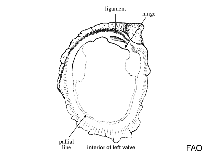Pseudochama exogyra (Conrad, 1837)
Reversed chamaGoogle image | No image available for this species;
drawing shows typical species in Chamidae.
Classification / Names Tên thường gặp | Các synonym ( Các tên trùng) | CoL | ITIS | WoRMS
Bivalvia | Venerida | Chamidae
Environment: milieu / climate zone / Mức độ sâu / distribution range Sinh thái học
. Subtropical
Distribution Các nước | Các khu vực của FAO | Các hệ sinh thái | Những lần xuất hiện | Những chỉ dẫn
Eastern Pacific: from USA to Mexico.
Length at first maturity / Bộ gần gũi / Weight / Age
Chín muồi sinh dục: Lm ? range ? - ? cmCommon length : 5.0 cm WD con đực/không giới tính; (Tài liệu tham khảo 310)
Short description Hình thái học
Life cycle and mating behavior Chín muồi sinh dục | Sự tái sinh sản | Đẻ trứng | Eggs | Sự sinh sản | Larvae
Main reference
Các tài liệu tham khảo | Người điều phối | Người cộng tác
Anonymous 2001 Classification of Southern California Chitons. California State University Fullerton, Department of Biological Science. http://biology.fullerton.edu/biol317/Murray/Fall97/chitons.html [accessed 27/01/06] (Tài liệu tham khảo 310)
IUCN Red List Status
(Tài liệu tham khảo 130435: Version 2025-1)
CITES status (Tài liệu tham khảo 108899)
CMS (Tài liệu tham khảo 116361)
Threat to humans
Human uses
| FishSource |
Các công cụ
Thêm thông tin
Thành phần thức ăn
Thành phần thức ăn
Các động vật ăn mồi
Max. ages / sizes
Length-weight rel.
Length-length rel.
Length-frequencies
Mass conversion
Sự phong phú
Các nguồn internet
BHL | BOLD Systems | CISTI | DiscoverLife | FAO(Publication : search) | Fishipedia | GenBank (genome, nucleotide) | GloBI | Gomexsi | Google Books | Google Scholar | Google | PubMed | Cây Đời sống | Wikipedia (Go, tìm) | Tạp chí Zoological Record



